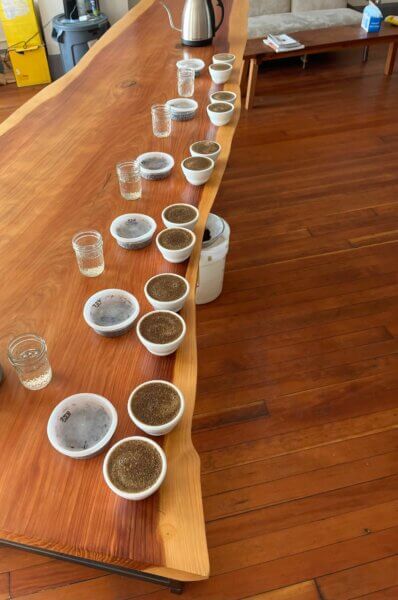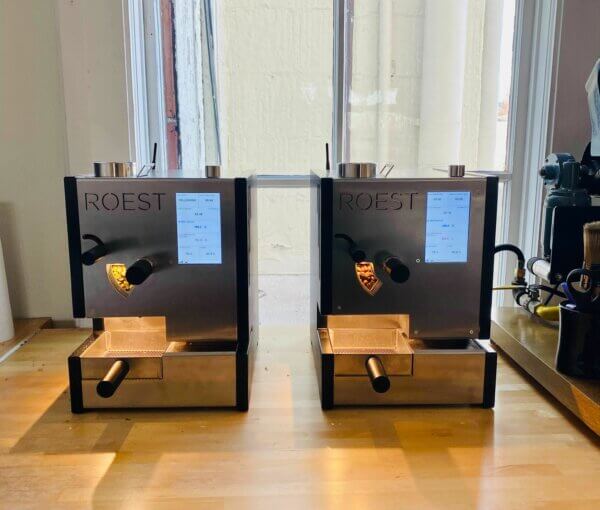One of the challenges we all face in the coffee industry is calibrating with customers on the taste of a coffee: what they mean when they use specific words, what they’re looking for, and what they enjoy. We all want to make sure we can quickly and easily discern what our roaster partners are looking for and the language they use to describe that. Roaster partners are doing the same work with their wholesale partners or cafe teams, and baristas at the cafe level are doing the same thing with their customers.
It’s a universal skill: decoding the language someone uses to figure out what they like and what they want. I talked with Red Fox global lab manager and veteran taster Joel Edwards on calibration and how to nail down shared vocabulary with customers.
Asking questions
The first step of calibrating with a customer is asking questions to get to know not just what they’re seeking at the moment but their general practices for assessing coffees.
Aside from asking what they’re looking for, “try to ask them questions about their protocols without being overly technical,” says Joel. “Do you roast and cup the same day? The next day? What’s your dose when cupping?” His goal here isn’t just to get a sense of their practices but also to start building a shared vocabulary—to grow your understanding of how they discuss tasting coffee.
“Sometimes a customer will tell me that instead of cupping, they brew up a large batch of Chemex coffee for their team to discuss,” he says. “That’s great intel because we know they’re doing something different so they may be tasting different things, which allows us to get on their level.”

Tasting together
A great next step is tasting coffees together (in person or long-distance) and seeing what language others use to describe them. The tasting doesn’t even need to be simultaneous to achieve deeper calibration.
“I send them coffees I’m very familiar with, maybe samples that are diverse, as a starting point to see what they like and how they describe it,” says Joel. If he sends a coffee that to him is an SCA 88 point coffee and they’re just not into it, “that’s great info for me. If I know they’re looking for balance, roundness, and sweetness over fruit-forward or floral profiles, that allows me to send them profiles that align with that in the future.” Using shared reference points (the actual coffee) lets him find out how their perceptions and vocabularies are similar and different as much as it allows him to find what they’re looking for.
“If a customer says ‘best coffee I’ve ever had. I gave it an 85.5,’ you’re able to see that their 85.5 is your 88+,” he says. “If you don’t take time to calibrate with them and they ask you for an 85 point coffee, you probably aren’t going to send them what they’re looking for. As much as we in the industry like to think there’s a universal point system, calibration is still a part of that system.”
Ironing out inconsistency
If a customer seems to be struggling with inconsistency and wants help, we have some approachable starting points. The first step is narrowing down whether they’re having a brewing or a roasting issue. From there, “If a customer is getting frustrated with inconsistency, I’ll talk to them about roasting procedures—just starting from really simple points like beginning each roast at the same drum temperature for a drum sample roaster,” says Joel. “If they have an automated machine like an Ikawa or a Roest, we can send them our profile. The more advice they want, the more we’ll give, but only if they ask.”

Subjectivity
Important to note is that flavors taste differently to different people. “An 85 isn’t an 85 to everyone,” says Joel. “Ultimately, notes and scores don’t equal a coffee. 85 is a broad category. Even 87 is a huge category.”
While flavor notes are key to calibration, Joel views them as a kind of necessary evil because they can reproduce an idea that coffee tastes exactly one way and those who don’t see that are wrong. “Notes are kind of the bane of my existence. They can be so evocative but they also feel reductive because they’re about comparison with other things we’ve experienced, not the exact thing that’s in the cup.” But, he says, we have to talk about the coffee somehow.
So how to navigate this reality? “I try to go as broad-strokes as possible with customers,” he says. “Red fruits or berry rather than Lingonberry, milk chocolate and nuts over a specific type of candy bar. Hearing customers describe a coffee back to me with the words that feel appropriate to them is so helpful.”
Words have broad meanings, especially when they relate to the senses. “What does someone mean when they say they’re lookin for a blender?” he asks. “Do they want brightness, complexity? What are they blending it with? Are they looking for something to fill out the lower notes in a blend, or are they looking for a cost-effective component?”
“Just like calibrating as a team is about bringing new members into our shared vocabulary, calibrating with customers is getting to know their vocabulary and finding our way to speak their language,” says Joel.
Specificity versus universality
Speaking of broad strokes, the further away from you someone is geographically, the more important to be mindful of choosing notes that are more universal than specific.
“Even with our Peru team, and especially with international customers, we can’t use the same fruits. It may not grow there, or they may not even know what it is and share that frame of reference,” he says. So “berry” is better than “Lingonberry,” but sometimes “fruity” is better than berry.
Building shared vocabulary over sharing your vocabulary
Overall, the process of calibration with a customer is not like training a new team member. With a new team member, you’re bringing them in. With a customer, you’re helping them bring you in. Hearing their preferences without any sense of judgment or evangelism is key in helping them get what they’re looking for, which benefits everyone involved at any level of purchasing.
If you have any questions or thoughts, get in touch and we’ll talk about it!
| Interested in sourcing coffee with us? Reach out at info@redfoxcoffeemerchants.com. To learn more about our work, check out our journal and follow us on Instagram @redfoxcoffeemerchants, Twitter @redfoxcoffee, Spotify, and YouTube. |
